How to Care for Baby Chicks
Inside: Learn how to properly care for baby chicks from the day you bring them home until they are 6 weeks old.
Have you ever been in your local feed store and seen all the cute baby chicks? Those little fluff balls can weaken the resolve of even the most stubborn of us. And hearing the cheep, cheep, cheep of them while they waddle around is one of the sweetest things to hear.
And while it is exciting to see the baby chicks in the feed store, there are several things you need to do before you bring those adorable creatures home. Baby chick care doesn’t have to be difficult, but you do need to be prepared to properly care for your baby chicks.
Before Getting Baby Chicks
The day you go pick up your chicks, be sure the farm store is your last stop. Have your brooder box set up in a safe place before you leave the house. Have lukewarm water and feed already inside the brooder and wood shavings or paper towels in the bottom.
Baby chicks don’t like to get cold so you want to bring them straight home after picking them up. Since your brooder should be set up and ready to go, you can place your chicks inside it as soon as you arrive home.
Don’t know how to set up a brooder for your baby chickens? This post will tell you how to set up a brooder in a plastic tote or a cardboard box to house your chickens in the first few weeks. You’ll also find information about the type of fresh bedding to use (pine shavings or paper towels, not cedar shavings) and info about supplemental heat options.
Bringing Baby Chicks Home
Once you arrive home with your new chicks, the first thing you should do is pick each one up from its box and inspect its behind for pasty butt (chicken droppings). If any have droppings stuck to their vent (behind) take a warm moist paper towel and gently remove the droppings.
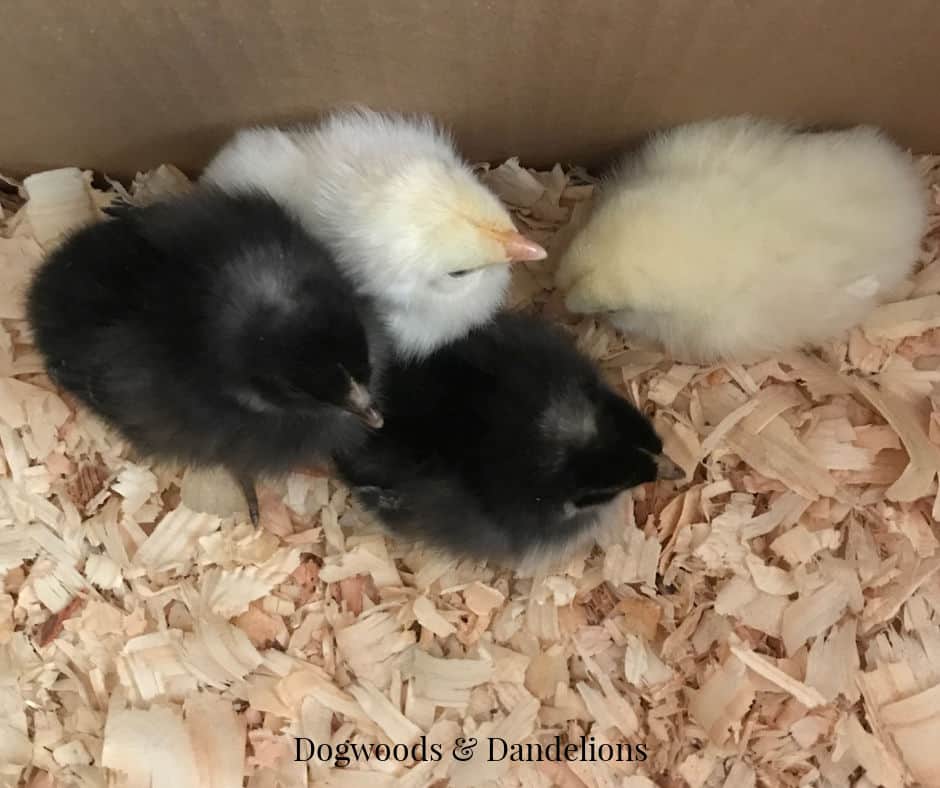
Affiliate Disclosure: Please note that some of the links in this article may be affiliate links and I may receive a small commission if you purchase something through a link. It will not change your cost. As an Amazon Associate, I earn from qualifying purchases. For more information, see my disclosures page.)
Day old chicks often get chilled in transit and being chilled can cause the poop to stick to their feathers around their vent.
If the droppings aren’t removed, they can clog the chick’s vent and lead to death. You should check your chicks for pasty butt every day until they are at least 2 weeks old.
Just before placing the chick in the brooder, gently place its beak in the warm water so that the baby chick knows where to find it. I do this with each and every chick before I place them in the brooder.
It is a good idea to keep a close eye on the chicks for the first couple of hours. If they don’t seem to be drinking, you may have to repeat the process of showing them the water. Usually, once one chick finds the water, the rest catch on fairly quickly.
On the first day, your chicks will likely sleep a lot. Try not to disturb them too much. They have had a rough time in transit and are tired.
As they get older, they will get more lively. By the time they are a few weeks of age, you may be wishing they slept more!
Monitor The Heat Source in the Brooder
If you are using a heat lamp, you will need to monitor the chicks to see if they are too hot or cold. They are too hot if they are running away from the lamp and standing in the corners of the brooder.
They are too cold if they are huddled together directly beneath the heat source. I really don’t recommend heat lamps. They are dangerous around flying birds and many homes and barns have been destroyed when a heat lamp has caused a fire.
If you do use a heat lamp (because I know some people will) you need to use a red bulb. The red light will help keep the chicks from pecking each other.
During the first week, you need to keep the brooder at about 95 degrees. A simple thermometer comes in handy.
Each week you need to lower the temperature of the brooder (by raising the heat lamp) by 5 degrees until the temperature is 70 degrees at week 6.
Instead of a heat lamp, I recommend an Eco-Glow brooder. These are so much safer. They use radiant heat to keep your chicks warm.
With a radiant brooder, you don’t have to worry about the brooder temperature and the chicks being too hot or too cold. The chicks will go under the heat source when they are cold and come back out to get food and water. You don’t have to monitor the temperature like you do with a heat lamp.
The only downfall to the Eco-Glow is that the room temperature where you are raising your baby chicks needs to be at least 55 degrees. A radiant brooder isn’t enough to keep baby chicks warm in a cold barn or garage.
For more information on why I chose an Eco-glow brooder, check out this post.)
Daily Baby Chick Care
Each day you will want to pick up the young chicks and look for any signs of pasty butt or illness. According to most statistics I’ve read, it is common for about 1 in 10 chicks to die in the first couple of weeks. However, in the 9+ years I’ve been raising chicks, we have only lost one!
You will also need to make sure they have plenty of food (chick starter feed) and clean water at all times. Clean out any wet bedding materials immediately.
You will probably have to clean your chick waterer every day, maybe even twice a day. Baby chicks are messy, messy, messy!
Maintaining a clean environment will help prevent health issues in your new flock.
As the Baby Chicks Grow
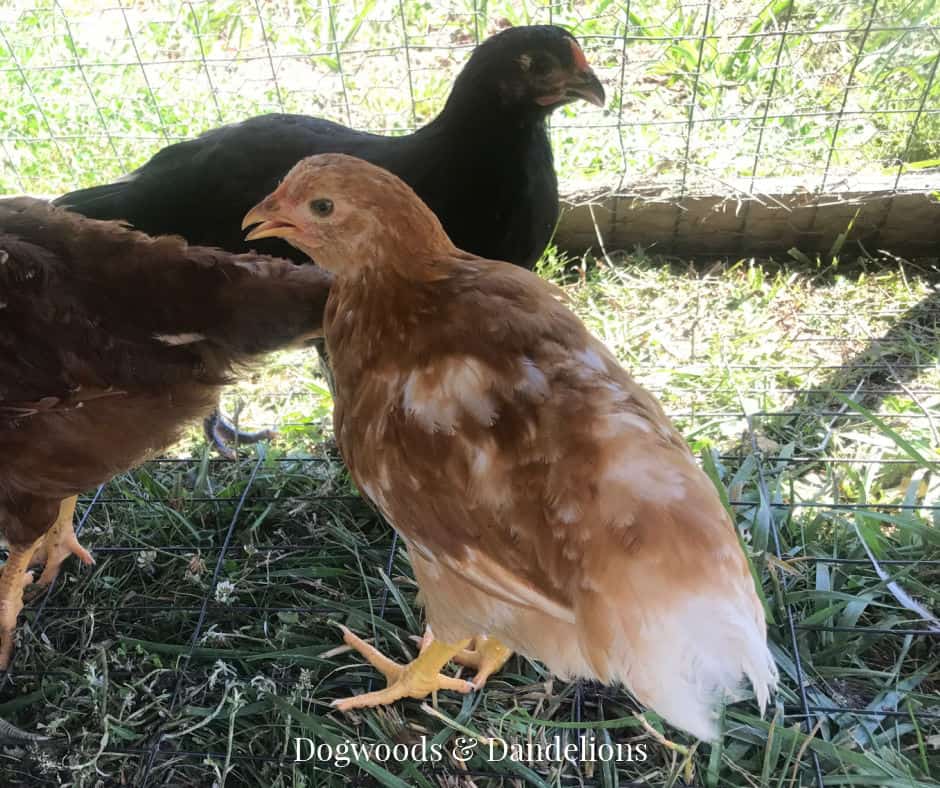
As the chicks grow, they will lose their soft, baby fuzz and start growing feathers. Many times, the “teenage” chicken looks much different from the baby chick. They can actually be quite ugly during this phase of rapid growth.
Learn what to expect each week in this Week by Week Guide to Raising Chickens.
Keep an eye on the chicks for signs of blood on their feathers. This can be the result of feathers growing in, but oftentimes it is the result of bullying from other chicks.
Sometimes the flock will gang up on just one chick. Other times, you may have one chick that is a “brooder bully.” The Chicken Chick has some great information about how to reform a “brooder bully.”
If one chick is injured, the wound needs to be attended to quickly. Other chicks will continue to peck at the blood on the injured chick. Usually, the injured chick will need to be separated from the others until it has fully healed.
I don’t give you this info to scare you, but I do want you to be prepared. Pecking by other chicks can be serious and can even lead to death if not handled quickly.
When to Move Baby Chicks Outdoors
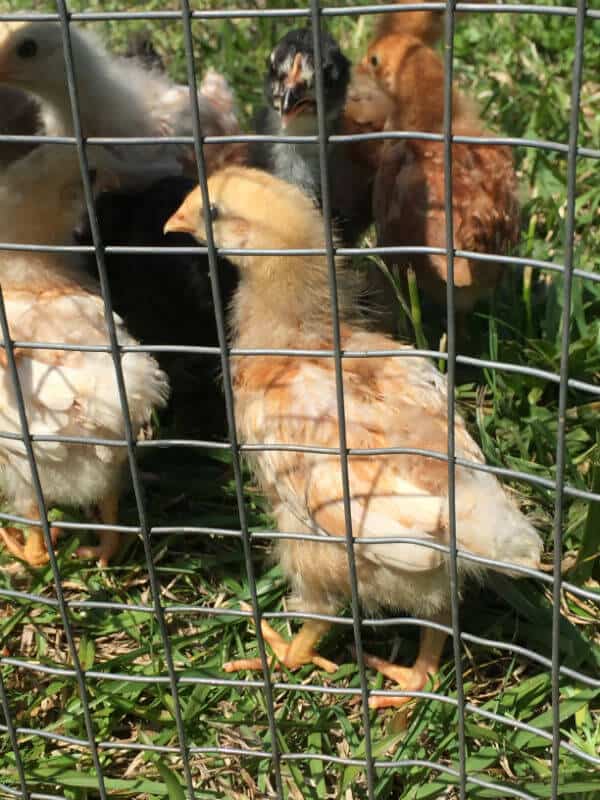
After the chicks are fully feathered, usually by 6 weeks old, they can be moved outdoors to a secure chicken coop during the day. When the outdoor temperatures are above 60 degrees at night, they can be moved outside permanently.
However, if the temperature will drop below 60 degrees Fahrenheit, they will need to be brought back inside to the brooder. The other option would be to provide a heat source for the outdoors.
Raising baby chicks doesn’t need to be complicated or expensive. And caring for baby chicks is a great learning activity for children and adults alike. The fresh eggs they will provide later are out of this world!
Do you have questions about caring for your new baby chicks? Drop a note in the comments and I’ll do my best to answer it.
Related Posts
- Friendliest Chicken Breeds
- How to know how many chicks you should get
- Foods You Shouldn’t Feed Your Chickens
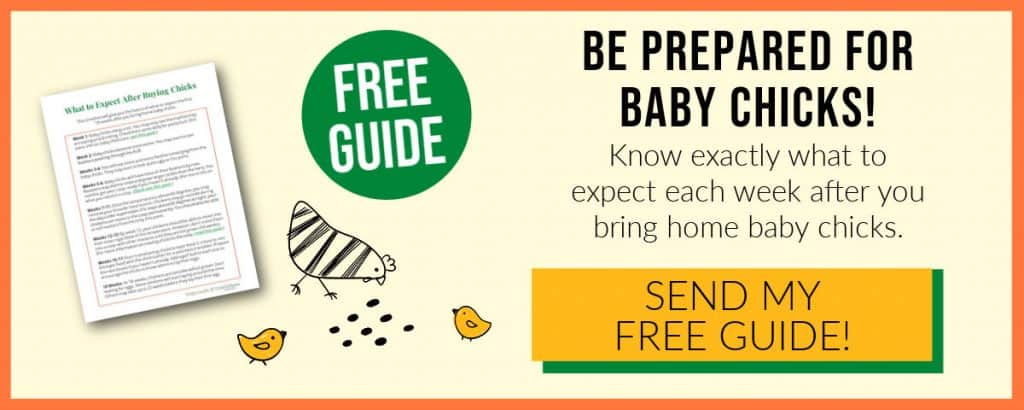

Meet Julie
I’m a farm girl born and bred in North Carolina. I’ve been growing a vegetable garden for over 20 years (and helping my Mom grow hers even longer). I’ve been raising chickens in my bathtub and backyard for 12+ years. I believe that homegrown food can be made simple. Let’s get started.
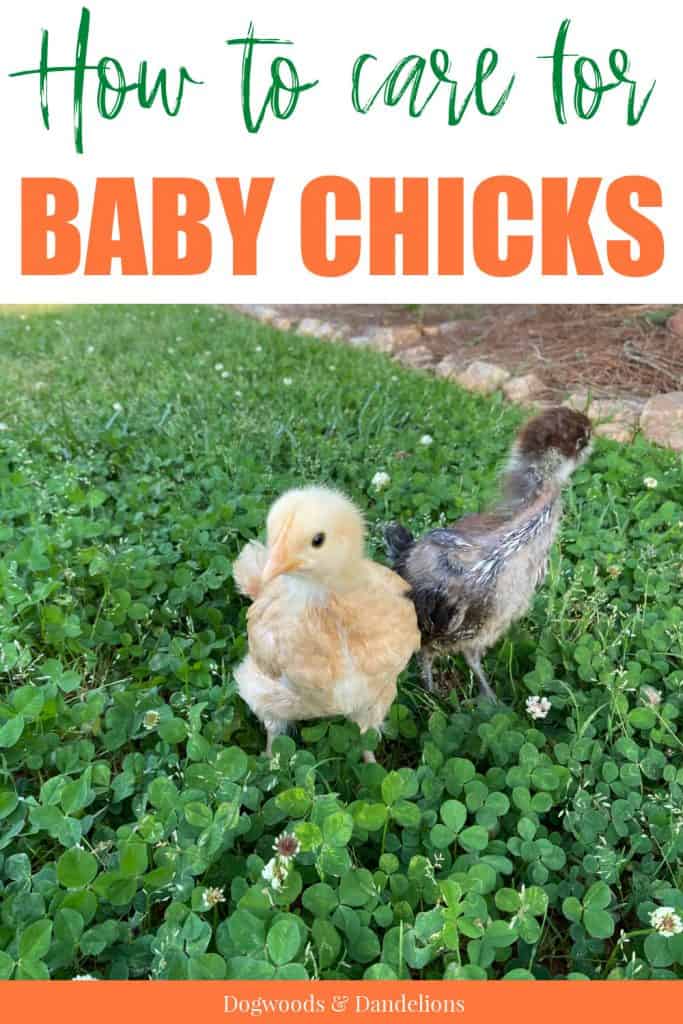


When raising chicks in the summer and outdoor temps are 90-95° does that affect the age they can be outdoors?
As long as they are safe from predators, they should be fine once they are fully feathered out. Until then, they still need to be kept warm overnight just like during the day. However, make sure they have plenty of water. It’s a good idea to have two waterers in case they knock one over.
Hi I have a couple of questions one, I’m picking my chicks up from a farm that’s an hour and half away. how would you travel with them safely and keep them warm? The other question I am getting two different age groups. My Rhode Islands will be brand new less than a week old, and my Easter Eggers will be 3 weeks old. Should I just keep them apart from the get go and introduce the Reds later when they are ready for the coop?
I would take a box to transport the chicks in, but be sure it has air holes so the chicks can breathe. If possible, put the box near a vent in your vehicle and run the heat while you bring them home. (You can roll the windows down for some cool air for yourself.)
Honestly, I would try them all together at first and keep a very close eye on them. That way you only have to have one heat source, feeder and waterer, not 2. I have done this with chicks 2 weeks difference in age and had no issues. However, if you notice the bigger ones picking on the younger ones, you will need to separate them and wait until they are full-grown to combine them. I would love to hear how it goes.
I have a snap together coop, getting ready for chicks this spring. Can I just put the brooder with the radiant heat source into the coop outside? I have a cat, and there is nowhere inside the house to put the brooder. I could also put packing blankets over the coop to secure heat stays inside…
Thank you. I have wishlisted the items you mention. (BTW: the radiant heat link is no longer available, but I saw another one similar…)
Thank you. I will be ready with reading your posts about the first few weeks of having chicks.
With a radiant brooder, you aren’t going to feel the heat unless you are underneath it so putting blankets over it is useless. Radiant heat passes through the air and is transmitted through electromagnetic waves. When these waves are intercepted and absorbed they are converted into heat. The radiant energy is absorbed by objects in the room and warms the space similar to the way your clothes absorb light from the sun. And unless it is already above 55 degrees outdoors, the radiant brooder will not keep the baby chicks warm enough. Your best bet would be to keep them in a room and keep the door closed to keep the cat out.
I see a small amount of blood in my chicks poop. What do I do?
I am not a veterinarian, so I can’t offer medical advice. However, this article may have some information that will help you. Good luck!